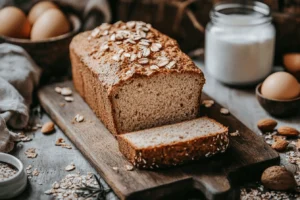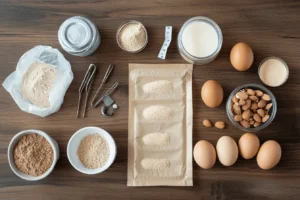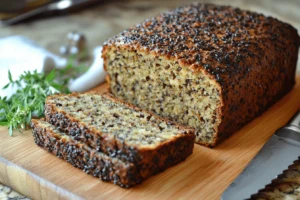How to Make the Perfect Protein Bread Recipe: Easy & Healthy Steps
Protein bread is a nutritious and versatile option for those looking to add more protein to their diet. This protein bread recipe guide covers everything from its benefits to step-by-step instructions, ensuring you can enjoy a healthier alternative to traditional bread. Whether you’re seeking gluten-free or vegan variations, this recipe is perfect for anyone looking to bake wholesome, delicious bread. Let’s get started!
Protein Bread Recipe
What is Protein Bread?
Protein bread isn’t your ordinary loaf. Unlike traditional bread, which relies heavily on refined flour, protein bread substitutes ingredients like whey protein powder, almond flour, or chickpea flour. These substitutions significantly increase its protein content while often reducing the carb count. That’s why it’s a favorite among fitness enthusiasts, keto followers, and anyone seeking better nutrition.
This bread boasts a dense yet soft texture, perfect for sandwiches, toast, or even a snack. You may notice that it doesn’t rise as much as regular bread, but don’t let that fool you—its nutrient profile makes up for it.
Why is Protein Bread Gaining Popularity?
There’s no denying that protein bread is a rising star in the health-conscious community. It aligns perfectly with trends like low-carb diets, high-protein meal plans, and gluten-free lifestyles. Plus, it’s versatile enough to suit various flavor preferences, whether you enjoy it savory or sweet.
Consumers are becoming more mindful of the nutritional content of their foods, and bread is no exception. Traditional loaves often get a bad rap for being high in carbs with minimal nutritional value. Protein bread flips that narrative by offering a wholesome alternative.
Nutritional Benefits of Protein Bread
The nutritional advantages of protein bread go beyond just being high in protein. It often contains:
- Fewer carbohydrates, making it suitable for low-carb or ketogenic diets.
- Added fiber from ingredients like psyllium husk or flaxseed meal, which supports digestion.
- Healthy fats from nuts or seeds, help you feel fuller for longer.
By choosing protein bread, you can meet your dietary goals without sacrificing taste or texture.
Why Make Protein Bread at Home?
Store-bought protein bread is convenient, but it often comes with added preservatives, artificial flavors, or hefty price tags. By baking your own, you control the ingredients, ensuring a healthier and more personalized loaf. Plus, it’s a fun and rewarding culinary adventure!
Benefits of Adding Protein to Your Bread
High-Protein Diets and Their Impact on Health
Incorporating more protein into your meals has numerous benefits, and bread enriched with high-protein ingredients can be a simple yet effective way to do this. High-protein diets are known to:
- Promote muscle growth and repair, making them ideal for active individuals or athletes.
- Enhance feelings of fullness, which can aid in weight management.
- Stabilize blood sugar levels, reducing energy crashes.
Protein is an essential macronutrient that supports virtually every cell in your body. When paired with fiber-rich ingredients, protein bread can also improve gut health.
Satiety and Weight Management Benefits
Ever find yourself reaching for a snack not long after a carb-heavy meal? Traditional bread can lead to quick spikes and drops in blood sugar, leaving you hungry sooner. Protein bread, on the other hand, digests more slowly, thanks to its higher protein and fat content. This not only keeps you full longer but can also help curb overeating.
Adding protein bread to your diet could be a smart move if you’re working on portion control. By keeping you satisfied for longer, it helps reduce unnecessary snacking—a win-win for weight maintenance or loss goals.
Nutritional Comparison with Regular Bread
Let’s take a closer look at how protein bread stacks up against regular bread:
| Nutrient | Traditional Bread | Protein Bread |
|---|---|---|
| Protein (per slice) | 2-4g | 8-12g |
| Carbohydrates | 15-20g | 5-10g |
| Fiber | 1-2g | 3-5g |
Protein bread often has more fiber, which further supports digestion and weight management. The additional protein also provides sustained energy, making it perfect for breakfast or a midday snack.
An Alternative to Store-Bought Options
While you can find protein bread in stores, they’re often overpriced and may not align with your taste preferences. Homemade protein bread is cost-effective and allows you to adjust ingredients for your dietary needs. Want a gluten-free loaf? No problem. Need vegan substitutions? Doable.
Essential Ingredients for Protein Bread
Common Protein Sources for Baking
The secret to a great protein bread recipe lies in the quality of its ingredients. By incorporating high-protein flours and powders, you can elevate a simple loaf into a nutritional powerhouse. Here are some popular protein sources used in baking:
- Whey Protein Powder: A versatile option that blends well and adds creaminess to your bread.
- Almond Flour: Naturally gluten-free, almond flour offers a mild, nutty flavor and is rich in healthy fats.
- Chickpea Flour: Packed with fiber and plant-based protein, it’s perfect for savory bread.
- Pea Protein Powder: A vegan-friendly protein that pairs well with other flours.
Each ingredient brings its unique benefits, so don’t hesitate to experiment to find what works best for your needs.
Balancing Macros in Protein Bread
While boosting protein is the goal, achieving the right balance of macronutrients—proteins, fats, and carbs—is essential. Overloading your bread with protein powder can result in a dense or overly dry texture.
Here’s how you can balance the macros in your bread:
- Protein: Use a blend of flours and powders for a consistent texture.
- Fats: Incorporate ingredients like eggs, Greek yogurt, or coconut oil for moisture.
- Carbs: Include small amounts of oat or tapioca flour to help the bread rise and hold its shape.
This balance not only improves taste but also enhances the bread’s nutritional profile, making it more satisfying.
Tips for Selecting Quality Ingredients
Not all ingredients are created equal. Choosing high-quality options ensures your protein bread turns out both delicious and nutritious. Here are a few tips:
- Look for unflavored or lightly flavored protein powders to avoid overpowering tastes.
- Opt for organic almond or chickpea flour for better flavor and fewer additives.
- Check the protein content per serving on labels to make informed decisions.
Using premium ingredients can make all the difference in texture and flavor, so it’s worth the effort to source the best.
Tools and Equipment Needed
Recommended Kitchen Tools for Protein Bread
The right tools can make baking protein bread a breeze. While you don’t need a professional setup, having these essentials will streamline the process and ensure consistent results:
- Mixing Bowls: Multiple sizes are ideal for separating wet and dry ingredients.
- Measuring Cups and Spoons: Precise measurements are critical for baking success.
- Whisk and Spatula: For smoothly combining ingredients without overmixing.
- Loaf Pan: A non-stick or silicone loaf pan is best for easy release and even baking.
For those who enjoy baking frequently, investing in durable and high-quality tools can make your experience more enjoyable.
Specialty Tools for Optimal Results
While not mandatory, certain tools can elevate your bread-making game:
- Bread Maker: Perfect for those who want a hands-off approach. Many machines have settings for protein-enriched recipes.
- Digital Kitchen Scale: Ensures accuracy when measuring ingredients like protein powders or flour.
- Silicone Baking Mat: Great for shaping dough and preventing sticking during prep.
These tools might seem optional, but they can greatly enhance the consistency and ease of your baking process.
Why Proper Equipment Matters
Baking is precise. Even small errors in measuring or mixing can result in a heavy, dry loaf instead of a light, fluffy one. For instance, a silicone loaf pan helps spread heat evenly, ensuring a golden crust without overbaking the middle.
By equipping your kitchen with the right tools, you’ll not only improve your protein bread recipe but also enjoy the process more. Plus, these investments often pay off in the long run by reducing waste and improving results.
Protein Bread Recipe Variations
Basic Protein Bread Recipe
A simple protein bread recipe is the perfect starting point for home bakers. It’s quick, versatile, and easy to adapt. Here’s a tried-and-true basic recipe:
Ingredients:
- 1 cup almond flour
- ½ cup whey protein powder (unflavored)
- 3 large eggs
- ¼ cup Greek yogurt
- 1 teaspoon baking powder
- ½ teaspoon salt
- Optional: 1 tablespoon flaxseed meal for added fiber
Instructions:
- Preheat your oven to 350°F (175°C) and prepare a loaf pan with parchment paper or non-stick spray.
- In a mixing bowl, whisk together the almond flour, protein powder, baking powder, and salt.
- In a separate bowl, beat the eggs and mix in the Greek yogurt.
- Combine the wet and dry ingredients, mixing gently until smooth.
- Pour the batter into the prepared loaf pan and smooth the top.
- Bake for 25–30 minutes or until a toothpick inserted into the center comes out clean.
Gluten-Free Protein Bread Option
For those avoiding gluten, this variation swaps out traditional flours entirely:
- Replace almond flour with coconut flour.
- Use 2 additional eggs to balance the moisture.
- Include a teaspoon of xanthan gum for better structure.
This loaf is slightly denser but still moist and flavorful, perfect for toasting.
Vegan Protein Bread Option
A vegan-friendly protein bread recipe removes all animal-based ingredients while still providing plenty of protein.
- Use 1 cup chickpea flour instead of almond flour.
- Replace eggs with a flaxseed egg substitute (1 tablespoon ground flaxseed + 3 tablespoons water per egg).
- Add 2 tablespoons of olive oil for extra moisture.
This plant-based version is ideal for vegans or those with egg allergies.
Sweet and Savory Adaptations
Protein bread is versatile enough to suit different flavor profiles:
- Sweet: Add a tablespoon of honey, a dash of vanilla extract, or even cinnamon for a breakfast-friendly loaf.
- Savory: Mix in shredded cheese, chopped herbs, or garlic powder for a flavor-packed side dish.
With these variations, you can tailor your bread to any preference or occasion, making it an essential addition to your kitchen repertoire.
Step-by-Step Instructions for Making Protein Bread
Preparing Your Ingredients
Before you begin, gather all your ingredients and ensure they’re measured correctly. Baking is precise, so having everything prepped avoids mistakes. Choose fresh, high-quality components, such as unflavored whey protein powder and almond flour, for the best results.
Mixing Dry Ingredients
In a large mixing bowl, combine the dry ingredients: almond flour, protein powder, baking powder, and salt. Use a whisk to evenly distribute the baking powder and eliminate clumps. This step ensures your bread rises uniformly and has a smooth texture.
Incorporating Wet Ingredients
In a separate bowl, beat the eggs until they’re light and frothy. Whisk in Greek yogurt, which adds moisture and creaminess to the batter. If you’re making a vegan version, prepare flax eggs by mixing ground flaxseed with water and letting it sit for five minutes before adding.
Combining Wet and Dry Ingredients
Gradually add the wet mixture to the dry ingredients. Stir gently to avoid overmixing, which can lead to a dense loaf. The batter should be thick but pourable. If it feels too dry, add a tablespoon of water or almond milk until you reach the desired consistency.
Preparing the Loaf Pan
Line your loaf pan with parchment paper or coat it lightly with non-stick spray. This ensures the bread doesn’t stick and makes for easy removal after baking.
Baking and Checking for Doneness
Pour the batter into the prepared pan, smoothing the surface with a spatula. Preheat your oven to 350°F (175°C) and bake for 25–30 minutes. To check for doneness, insert a toothpick into the center of the loaf—if it comes out clean, your bread is ready.
Cooling and Serving
Allow the bread to cool in the pan for 10 minutes before transferring it to a wire rack. This step prevents sogginess. Once cooled, slice and enjoy! Protein bread pairs perfectly with spreads like almond butter for a sweet treat or avocado for a savory snack.
Troubleshooting Common Issues
If your bread doesn’t rise or turns out dry, don’t fret! Here are some quick fixes:
- Bread is too dense: Ensure your baking powder is fresh, and avoid overmixing the batter.
- Bread is dry: Add a little extra liquid, like Greek yogurt or almond milk, to the mix next time.
- Loaf sinks in the middle: Bake longer, ensuring the center is fully cooked before removing it from the oven.
Mastering these steps ensures you’ll create a protein bread recipe that’s not only delicious but also perfectly textured every time!
Storing and Preserving Protein Bread
Proper Storage for Freshness
Protein bread, like any homemade baked good, requires proper storage to maintain its texture and flavor. Since it lacks preservatives found in store-bought bread, you’ll want to take extra care:
- Room Temperature: If you plan to eat the bread within 2–3 days, wrap it tightly in plastic wrap or store it in an airtight container. Keep it in a cool, dry place to prevent moisture buildup.
- Refrigeration: For longer storage (up to a week), refrigerate the bread in a sealed container or wrapped in aluminum foil. This slows down spoilage while keeping it fresh.
Avoid storing protein bread in the open air, as it can dry out quickly due to its low-fat content.
Freezing Protein Bread
Freezing is an excellent option for extending the shelf life of your protein bread recipe. Here’s how:
- Let the bread cool completely after baking.
- Slice the loaf into portions for easy thawing later.
- Wrap each slice individually in plastic wrap to prevent freezer burn.
- Place the slices in a resealable freezer bag or airtight container.
Frozen protein bread can last up to three months. To enjoy, thaw slices at room temperature or reheat them in a toaster or microwave.
How to Keep Protein Bread Moist
The high protein content in this bread can make it prone to dryness if not stored correctly. To retain moisture:
- Include ingredients like Greek yogurt or olive oil in the recipe for added hydration.
- Reheat slices with a damp paper towel in the microwave to bring back softness.
Repurposing Leftover Bread
If your bread starts to go stale, don’t toss it! Protein bread can easily be repurposed:
- Make protein-packed croutons by cubing and toasting them with olive oil and herbs.
- Use it as a base for French toast or bread pudding.
- Blend it into breadcrumbs for recipes like meatballs or casseroles.
By storing and repurposing wisely, you can enjoy every last slice of your homemade protein bread.
Nutritional Profile of Protein Bread
Protein bread stands out for its impressive nutritional content. Compared to traditional bread, it offers a healthier balance of macronutrients, making it ideal for various diets. Each slice typically contains:
- Protein: 8–12 grams, depending on the recipe, supporting muscle repair and satiety.
- Carbohydrates: 5–10 grams, making it a great choice for low-carb or keto lifestyles.
- Fiber: 3–5 grams, aiding digestion and promoting gut health.
Its nutrient density makes it an excellent option for meals, snacks, or post-workout recovery. Additionally, ingredients like almond flour and flaxseed provide heart-healthy fats and essential vitamins.
How Protein Bread Compares to Traditional Bread
Here’s a quick breakdown to highlight the differences:
| Nutrient | Traditional Bread | Protein Bread |
|---|---|---|
| Protein (per slice) | 2–4 grams | 8–12 grams |
| Carbohydrates | 15–20 grams | 5–10 grams |
| Fat | 1–2 grams | 4–6 grams |
| Fiber | 1–2 grams | 3–5 grams |
Protein bread not only reduces carbs but also adds beneficial nutrients that help you feel fuller longer.
Adjusting Macros for Specific Needs
Depending on your dietary goals, you can tweak the recipe to better suit your needs:
- For Higher Protein: Add a tablespoon of whey protein powder or use egg whites for additional protein without increasing fat.
- For Lower Carbs: Replace almond flour with coconut flour, which is lower in carbs but absorbs more liquid (adjust the recipe accordingly).
- For More Fiber: Include ingredients like psyllium husk or chia seeds to boost the fiber content.
With these simple adjustments, you can customize your protein bread recipe to fit perfectly into your nutrition plan.
A Versatile Nutritional Powerhouse
Whether you’re following a fitness-focused meal plan or just looking for a healthier alternative to traditional bread, protein bread offers a wealth of benefits. Its versatility and nutrient profile make it a fantastic choice for breakfast, lunch, or dinner. Plus, knowing its nutritional breakdown helps you make informed decisions about incorporating it into your diet!
Customizing Protein Bread Recipes
Adding Seeds, Nuts, or Toppings
One of the best things about a protein bread recipe is how customizable it can be. By incorporating seeds, nuts, or other toppings, you can create a loaf that suits your taste and dietary goals. Consider these options:
- Seeds: Chia seeds, flaxseeds, or sunflower seeds add texture, healthy fats, and fiber.
- Nuts: Crushed almonds, walnuts, or pecans offer crunch and a rich, nutty flavor.
- Toppings: Sprinkle sesame seeds, rolled oats, or shredded coconut on top before baking for a decorative and flavorful crust.
These additions not only enhance the taste but also boost the nutritional profile, making your bread even healthier.
Using Alternative Protein Powders
The type of protein powder you use can drastically change the flavor and texture of your bread. Here’s a guide to choosing the right one:
- Whey Protein Isolate: Light and creamy, ideal for fluffy bread.
- Pea Protein: A plant-based option that blends well with nut flours.
- Collagen Powder: Adds a subtle flavor and improves the loaf’s elasticity.
- Casein Protein: Denser and creamier, great for creating moist bread.
Experimenting with different protein powders allows you to find the perfect match for your dietary needs and flavor preferences.
Enhancing Flavor with Spices and Herbs
Turn your protein bread into a gourmet treat by adding spices or herbs to the batter:
- Savory Loaf: Incorporate garlic powder, rosemary, or thyme for a flavor-packed side dish.
- Sweet Loaf: Add cinnamon, nutmeg, or a touch of vanilla extract for a breakfast-friendly option.
These simple tweaks can transform a basic loaf into something extraordinary.
Personalized Protein Bread for Every Diet
Whether you’re keto, vegan, or gluten-free, protein bread can be adapted to fit your lifestyle. By tweaking ingredients and adding your favorite flavors, you’ll have a bread recipe that’s as unique as your needs. Customizing makes your bread more enjoyable and ensures it aligns perfectly with your health goals!
Health Benefits of Protein Bread in Daily Diet
Protein Bread as a Nutritional Boost
Incorporating protein bread into your diet is a fantastic way to enhance your daily nutrition. Each slice provides a higher protein content compared to traditional bread, supporting muscle repair and sustained energy levels. Whether you’re a fitness enthusiast or simply seeking a healthier lifestyle, protein bread offers benefits that cater to various dietary goals.
Ideal for Post-Workout Recovery
After an intense workout, your muscles need protein to recover and rebuild. A slice of protein bread, paired with a spread like almond butter or avocado, delivers the perfect balance of protein, fats, and carbohydrates to replenish your energy and fuel recovery.
Great for Meal Prep
Protein bread is versatile and convenient, making it an excellent choice for meal prepping. It can be used to create:
- Sandwiches with high-protein fillings like turkey, chicken, or tofu.
- Breakfast toast topped with eggs, smoked salmon, or peanut butter.
- Croutons for salads or soups, add both texture and nutritional value.
Supports Weight Management Goals
Thanks to its higher fiber and protein content, protein bread promotes satiety and reduces cravings throughout the day. This makes it a valuable tool for managing portion sizes and avoiding unnecessary snacking.
Balances Blood Sugar Levels
Unlike traditional bread, which can cause rapid blood sugar spikes, protein bread’s lower carbohydrate content and higher fiber help stabilize blood sugar levels. This makes it a suitable option for individuals managing diabetes or insulin sensitivity.
A Wholesome Addition to Any Diet
Whether you’re looking to build muscle, lose weight, or simply make healthier choices, protein bread fits seamlessly into any diet. Its versatility allows you to enjoy it in countless ways, and its nutritional benefits make it a smart, satisfying alternative to regular bread.
Incorporating protein bread into your daily meals can revolutionize the way you enjoy bread while supporting your health and fitness goals.




